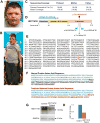Epigenetics and autism spectrum disorder: A report of an autism case with mutation in H1 linker histone HIST1H1E and literature review
- PMID: 29704315
- PMCID: PMC5980735
- DOI: 10.1002/ajmg.b.32631
Epigenetics and autism spectrum disorder: A report of an autism case with mutation in H1 linker histone HIST1H1E and literature review
Erratum in
-
Erratum.Am J Med Genet B Neuropsychiatr Genet. 2019 Jun;180(4):287. doi: 10.1002/ajmg.b.32725. Epub 2019 Mar 27. Am J Med Genet B Neuropsychiatr Genet. 2019. PMID: 31056832 No abstract available.
Abstract
Genetic mutations in genes encoding proteins involved in epigenetic machinery have been reported in individuals with autism spectrum disorder (ASD), intellectual disability, congenital heart disease, and other disorders. H1 histone linker protein, the basic component in nucleosome packaging and chromatin organization, has not been implicated in human disease until recently. We report a de novo deleterious mutation of histone cluster 1 H1 family member e (HIST1H1E; c.435dupC; p.Thr146Hisfs*50), encoding H1 histone linker protein H1.4, in a 10-year-old boy with autism and intellectual disability diagnosed through clinical whole exome sequencing. The c.435dupC at the 3' end of the mRNA leads to a frameshift and truncation of the positive charge in the carboxy-terminus of the protein. An expression study demonstrates the mutation leads to reduced protein expression, supporting haploinsufficiency of HIST1H1E protein and loss of function as an underlying mechanism of dysfunction in the brain. Taken together with other recent cases with mutations of HIST1H1E in intellectual disability, the evidence supporting the link to causality in disease is strong. Our finding implicates the deficiency of H1 linker histone protein in autism. The systematic review of candidate genes implicated in ASD revealed that 42 of 215 (19.5%) genes are directly involved in epigenetic regulations and the majority of these genes belong to histone writers, readers, and erasers. While the mechanism of how haploinsufficiency of HIST1H1E causes autism is entirely unknown, our report underscores the importance of further study of the function of this protein and other histone linker proteins in brain development.
Keywords: behavior characterization; epigenetic machinery; neurodevelopment; whole exome sequencing.
© 2018 Wiley Periodicals, Inc.
Figures


References
-
- Allan J, Mitchell T, Harborne N, Bohm L, Crane-Robinson C. Roles of H1 domains in determining higher order chromatin structure and H1 location. J Mol Biol. 1986;187(4):591–601. - PubMed
-
- Allis CD, Jenuwein T. The molecular hallmarks of epigenetic control. Nat Rev Genet. 2016;17(8):487–500. - PubMed
-
- Amir RE, Van den Veyver IB, Wan M, Tran CQ, Francke U, Zoghbi HY. Rett syndrome is caused by mutations in X-linked MECP2, encoding methyl-CpG-binding protein 2. Nat Genet. 1999;23(2):185–188. - PubMed
Publication types
MeSH terms
Substances
Grants and funding
LinkOut - more resources
Full Text Sources
Other Literature Sources
Medical

